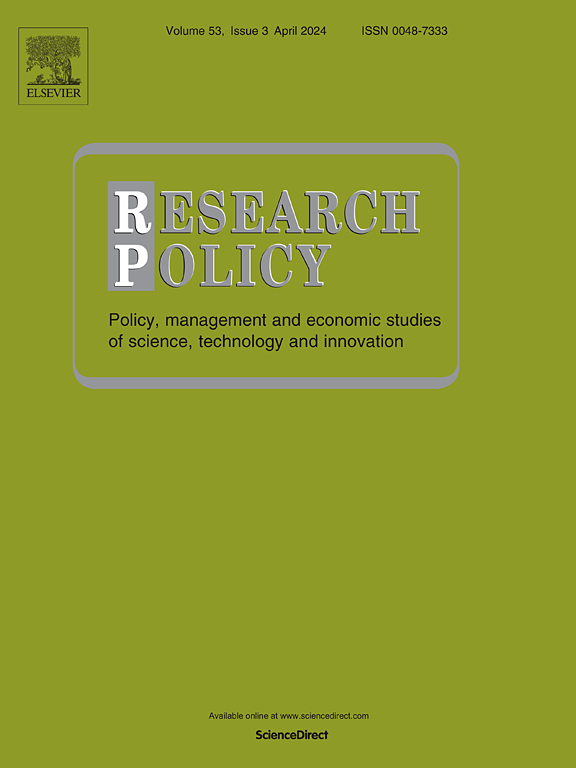顶尖研究型大学领导层中的顶尖研究人员:元研究分析
IF 7.5
1区 管理学
Q1 MANAGEMENT
引用次数: 0
摘要
目前还不清楚顶尖研究人员在多大程度上以校长或执行董事会成员的身份参与了顶尖研究型大学的领导工作。我们对美国 146 所卡内基一级大学和《泰晤士高等教育》(THE)2024 年排名前 100 所大学的学术行政领导(校长或同等职务)以及《泰晤士高等教育》2024 年排名前 20 所大学的行政管理机构(董事会、理事会、公司或类似机构)的成员进行了研究,以了解他们在各自科学子领域的高被引影响。高被引的定义是:根据截至 2022 年底的职业生涯影响,在所有专注于同一子领域并发表过≥5 篇完整论文的学者中,在其主要科学子领域的综合引文指标(考虑了被引次数、h 指数、合著调整后的 hm 指数以及作为单一、第一和最后作者的论文被引次数)中排名前 2%的学者。极高被引率同样被定义为前 0.2%。根据 Science-Metrix 的分类,科学被分为 174 个领域。截至 2023 年底,38/146(26%)所美国一级大学的领导者为高被引者,5/146(3%)为非常高被引者。全球排名前 100 位的 THE 2024 大学的相关数据分别为 43/100 和 12/100。在 "THE 2024 "排名前 20 的 13 所美国大学中,其领导被高度引用的概率(6/13,46%)低于从其教师队伍中随机选取的在职终身教授被高度引用的概率(52-77%)。在有数据的 14 所排名前十的 THE 2024 大学的 444 名董事会成员中,只有 65 名(15%)是学者,19 名(4%)是高被引学者;学者在美国大学董事会中很少见。董事会成员主要在营利性公司工作。总之,一流研究型大学缺乏具有高影响力研究人员的领导者。本文章由计算机程序翻译,如有差异,请以英文原文为准。
Leading researchers in the leadership of leading research universities: Meta-research analysis
It is unknown to what extent leading researchers are currently involved in the leadership of leading research universities as presidents or as executive board members. The academic administrative leader (president or equivalent role) of each of the 146 Carnegie tier 1 USA universities and of any of the top-100 universities per Times Higher Education (THE) 2024 ranking and the members of the executive governing bodies (Board of Trustees, Council, Corporation or similar) for the each of the top-20 universities per THE 2024 ranking were examined for high citation impact in their scientific subfield. Highly-cited was defined as the top-2 % of a composite citation indicator (that considers citations, h-index, co-authorship adjusted hm-index and citations to papers as single, first, last authors) in their main scientific subfield based on career-long impact until end-2022 among all scholars focusing in the same subfield and having published ≥5 full papers. Very highly-cited was similarly defined as the top-0.2 %. Science was divided into 174 fields per Science-Metrix classification. 38/146 (26 %) tier 1 USA university leaders as of end-2023 were highly-cited and 5/146 (3 %) were very highly-cited. The respective figures for the top-100 THE 2024 universities globally were 43/100 and 12/100. For the 13 US universities among the top-20 of THE 2024, the probability of their leader being highly-cited was lower (6/13, 46 %) than the probability of a randomly chosen active full tenured professor from their faculty being highly-cited (52–77 %). Across 444 board members of 14 top-10 THE 2024 universities with data, only 65 (15 %) were academics, and 19 (4 %) were highly-cited; academics were rare in USA university boards. Board members had predominantly careers in for-profit companies. In conclusion, leading research universities have a dearth of leaders who are high-impact researchers.
求助全文
通过发布文献求助,成功后即可免费获取论文全文。
去求助
来源期刊

Research Policy
MANAGEMENT-
CiteScore
12.80
自引率
6.90%
发文量
182
期刊介绍:
Research Policy (RP) articles explore the interaction between innovation, technology, or research, and economic, social, political, and organizational processes, both empirically and theoretically. All RP papers are expected to provide insights with implications for policy or management.
Research Policy (RP) is a multidisciplinary journal focused on analyzing, understanding, and effectively addressing the challenges posed by innovation, technology, R&D, and science. This includes activities related to knowledge creation, diffusion, acquisition, and exploitation in the form of new or improved products, processes, or services, across economic, policy, management, organizational, and environmental dimensions.
 求助内容:
求助内容: 应助结果提醒方式:
应助结果提醒方式:


